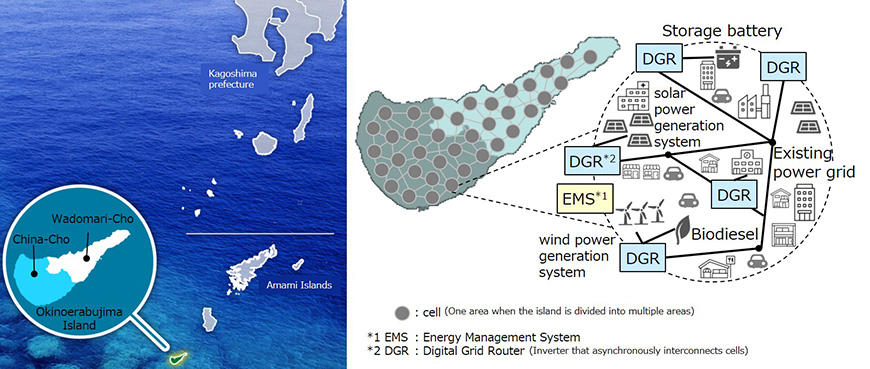*as of October 28, 2021
Comprehensive Partnership Agreement Overview
The three parties will prepare construction plans for the microgrid by March 31, 2022, which will utilize renewable power generation and storage batteries to supply power throughout Okinoerabu Island. After feasibility verification, construction is expected to begin after April 2022. The project has been selected by Japan's Ministry of Economy, Trade, and Industry (METI) for a subsidy promoting community cooperation through the use of renewable energy.
The microgrid will require no new power lines, instead utilizing the existing power distribution network under license to serve consumers throughout the island. It will generate carbon-free power with a combination of a solar power generation system, wind power generation system, storage batteries, and an energy management system (EMS) that balances power supply and demand.
As a result, the towns of China-cho and Wadomari-cho plan to use renewable energy as their primary power source leveraging the EMS and storage battery technologies to overcome the intermittency of solar and wind solutions, and provide consistent power even during emergencies or natural disasters. The parties also plan to create local jobs by establishing a local power company on the island to maintain the microgrid facilities.

Okinoerabu Island Microgrid Concept
Background
The residents of China-cho+ and Wadomari-cho are acutely aware of the need to reduce carbon emissions. The towns currently rely on diesel-fueled power generation that releases a significant amount of greenhouse gases, and their renewable energy deployment remains low. In addition, typhoons and other challenges create frequent power outages on the island -- sometimes requiring days to restore -- and transportation of liquid fuel for diesel generators is difficult during turbulent weather. The agreement to build a renewable-energy microgrid will reduce carbon emissions throughout the island while improving power supply reliability, economic development, and power rates to consumers.
Timeline
-September 2021 to March 2022: Develop plans for microgrid deployment on the island
-After April 2022: Construct microgrid; install solar modules, storage batteries, EMS, and related equipment
*Microgrid: a small-scale energy network enabling local power production for local consumption using community-based energy sources and facilities instead of a large-scale power plant.
+In September 2020, China-cho declared a climate emergency, aiming to reduce its CO2 emissions to zero by 2050.







